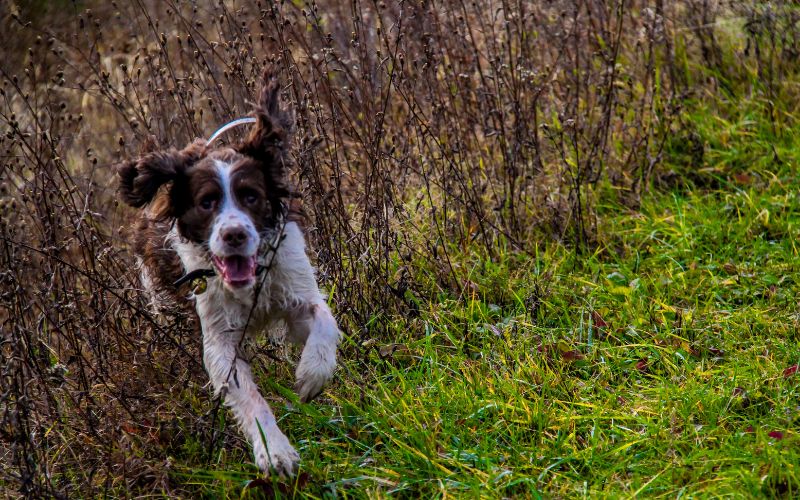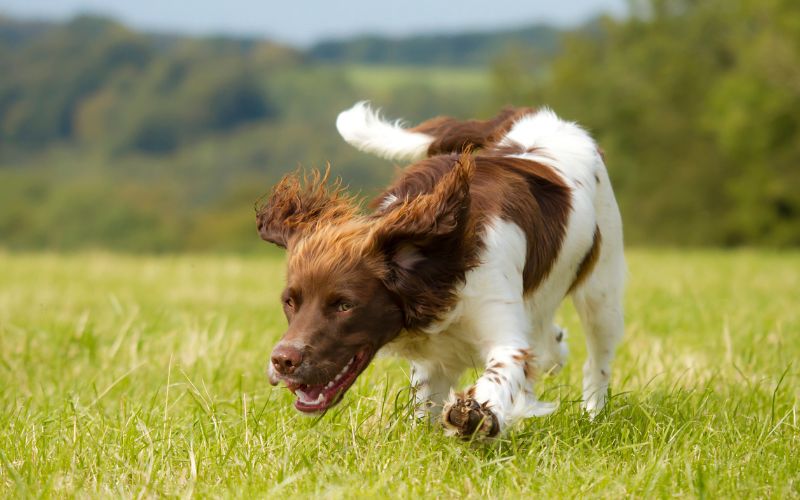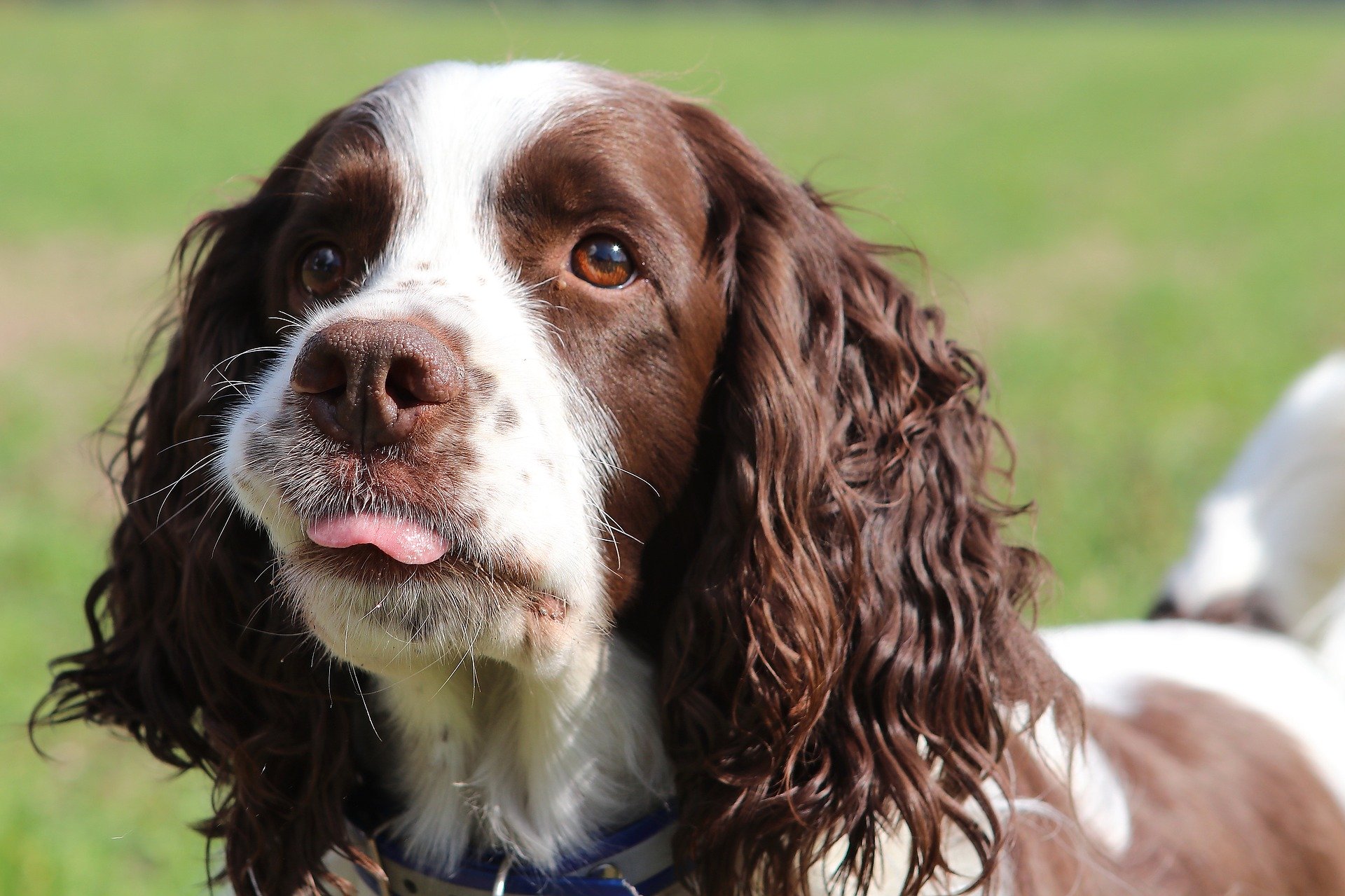A key area of spaniel training is that of steadiness and stopping on the whistle.
In the shooting environment you will need your spaniel to stop when he flushes game and when you are handling him onto retrieves.
The use of the stop whistle builds on the other areas of training that you will have undertaken and builds on the sit command and hand signal.
Stopping on the whistle is a key area of spaniel work and will be one of the most important and probably demanding aspects of your spaniel training. With some care, thought and persistence your spaniel will soon stop when you blow your whistle and should do so every time.
Why do we need a spaniel to stop on the whistle?
Teaching a spaniel to stop on the whistle is the basis of steadiness to stopping when we are out on a shoot, beating or walked up shooting for example.
If you consider the scene, we are walking up, looking for game, shotgun under arm.
Our spaniel is out ahead of us, hunting the ground. A pheasant gets up, or a rabbit breaks cover.
Now, if our dog chases the game then we cannot take the shot, to do so would be stupid and dangerous, there’s a chance that we would shoot the dog.
So we lose the shot, the game escapes, the dog comes back when he feels like it – it’s tricky to get a dog back when he is in the full ‘blood to the head’ experience of chasing an animal.
And we get frustrated.

Rather than take the chance, we work with our young spaniel to steady him to the whistle first.
This serves several purposes.
First, we are able to have more control over him in general, not just when he finds game.
We can stop him when hunting which we might need to do, to maybe adjust clothing, take a breather, decide which way we are going etc etc.
Secondly, if our dog is compliant to the stop whistle, then we can stop him when he finds game and prevent him from chasing after it – which is what we need.
Overall, a dog that stops to the whistle is safer, easier to control and much more capable as a gundog and pleasant to work with.
Stopping on the whistle is an important aspect of a spaniel’s training. It encourages steadiness and provides an extra way to control your dog while he is hunting.
Before training a gundog to stop on the whistle
If you have been reading the articles on the site that I have written then you’ll have seen that one of the first stages in training a spaniel puppy was that of the ‘sit’ or ‘hup’ command, where we get our puppy to sit down when told.
This is an easy command to introduce your puppy to and, if you haven’t done this then you must start with the basics, you cannot work towards whistle steadiness and stopping on the whistle before you’ve got compliance with the sit command.
To see how we get a puppy to sit down read the article here on introducing that command.
Training a spaniel to stop on the whistle
The stop whistle is an important progression in your dog’s training and, although it may seem complex and an advanced aspect of training, it is relatively straightforward to introduce.
Once we have our puppy sitting when asked, either by the command’ hup’ or ‘sit’, we can progress.
Your dog should also understand and recognise the hand signal that we use alongside the verbal command.
Training is a step by step process
Understanding that all spaniel training is like a chain of learning it becomes simple to introduce the whistle.
As you tell your puppy to sit or hup, as he does so give a long blow on the whistle and hold your hand up to give the hand signal too.
He won’t understand the whistle command, but he does know what hup means and he does know what the hand signal means, so he should sit down.
When he does give the usual praise.
From this point on, everytime you hup him give the whistle also.
As you progress, rather than give the verbal command, give the hand signal and the whistle.
Mix it up a bit and keep the exercise going.
Like all things, little and often and don’t rush.
More advanced stop whistle training
I’ve titled this as more advanced stop whistle training but, in reality, it’s just taking things a little bit further.
Take your spaniel out, either in the garden or somewhere where you can grab him easily.
Let him run freely around, and, give the whistle command for him to stop.
One of two things will happen, he’ll either drop quickly ( which is great ) or he’ll carry on running around.
If he doesn’t stop ( and you’ve taken your time and got him sitting down before ) then, get after him without making a fuss, take him gently by the scruff and take him back to the spot where he should have stopped when you blew the whistle.
Repeat the whistle command and reinforce it with the hand signal and the verbal command.
Then, let him run and quickly repeat the whistle, reinforced with the verbal command and hand signal.
Remember, if he doesn’t listen to the whistle at first, you’ve always got the verbal command, which you can shout, and the hand signal as back ups.
Be prepared to use them while he gets good at stopping on the whistle.

Stopping a spaniel while hunting
Hopefully you’ll be getting an idea of the training strategy that we are adopting in training a spaniel puppy, with one exercise leading onto another, more advanced exercise.
We start with easy to manage and control activities, where we can help our dog, and gently correct and show him when needed, this is true of everything including his hunting.
Most spaniels will hunt freely and are quite happy to do so if we let them.
Some can be a bit reluctant to do so, particularly if they are sensitive, so we have to be a bit measured in our approach to hunting and let a sensitive puppy get on with it a bit more without interference.
When you start to stop your spaniel on the whistle when he is hunting, you may find that he becomes a little bit ‘sticky’. This is normal for many dogs.
He’s simply wondering what you want. All you need to do is be economic with the amount of times that you stop him, in other words don’t do it a lot.
Making progress
If you’ve worked along with stopping your dog on the whistle, you should be at a stage where he sits when the whistle is blown, and he stops when he is running around the garden freely.
It should not be too hard now to stop him when he is hunting.
Go somewhere where there is a bit of light cover ( rushes or long grass are ideal).
Set your puppy off hunting and remember the quartering exercises and the wind direction.
Let him get going well and try to keep him close to you.
As he crosses your path, when he is closest, blow a long blast on your whistle to stop him.
If he ignores you, get him and drag him back to the spot where he should have stopped, and repeat the whistle command accompanied by the verbal and hand signal.
Now, if the homework has been done then, chances are he’ll stop.
He may not sit down, many spaniels don’t and this can be a sign of a clever dog, as he’s waiting to see what you want..are you sending him for a retrieve? Can he see if he’s sat down?
But, if he does stay standing then encourage him, as a youngster, to sit down.
Progress carefully with this and don’t stop him more than maybe twice when he’s hunting, more than this and he’ll get sticky with his hunting.
Again, little and often is the way. Don’t be in a rush, take your time and your spaniel will come along nicely.
Final words
Stopping on the whistle is an important step in your spaniel’s training and forms the basis of future steadiness work.
Begin slowly and gradually work on the command with your dog in different environments and conditions, so that he becomes familiar with the instruction in a variety of situations.




